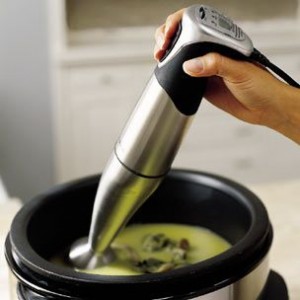Pureeing soup
The advent of the blender (including the handheld immersion blender) has made it possible to puree almost any vegetable soup, and many others as well. (As it happens, however, a hand-cranked food mill is usually just as easy.) Thicken purees if you like, stir in some cream, milk, half-and-half, yogurt, sour cream, or creme fraiche – any liquid dairy product can be used to enrich and adjust the thickness of purees. If your puree is too thick, stir in some water or, better still, half-and-half, which will add flavor, enhance texture, and thin the soup out all at the same time. If your puree is too thin (maybe you should have added that potato after all), stir in some thick cream, such as heavy cream or sour cream; it will add flavor and make the soup a little thicker.
 It’s worth noting that, except for the guilt induced by its fat content, heavy cream is almost always preferable. It adds great flavor and texture, and you don’t need much — one-half cup, or even less, is usually enough to have a wonderful impact on six cups of soup (of course more has even more of an impact).
It’s worth noting that, except for the guilt induced by its fat content, heavy cream is almost always preferable. It adds great flavor and texture, and you don’t need much — one-half cup, or even less, is usually enough to have a wonderful impact on six cups of soup (of course more has even more of an impact).
Heating stock for use in soup
Most soups begin by cooking some meat or vegetables, then adding stock or water. If you heat the stock or water while you prepare the solid ingredients, you will cut your cooking time, usually by as much as ten or fifteen minutes. For that reason, when I list stock as an ingredient in soups, I write, “preferably warmed.” You can add ice-cold stock, of course, if you would rather not dirty an extra pot.
Adding pasta to soup
Most soups rely on starches such as rice, pasta, or bread for body. But pasta, especially, is sometimes better cooked in separate water. Large amounts of pasta absorb so much water and give off so much starch that cooking it directly in a soup may change the character entirely. (There is nothing wrong with this, of course, but you should be aware of it.) My sometime preference, then, is to precook large amounts of noodles before adding them to soup. When, however, you’re adding a little small pasta to soup — such as a few tablespoons of orzo – just cook it directly in the simmering broth, stirring frequently.
Storing soups
Many soups can be made in advance, or at least partly so; I’ve noted the best time to interrupt cooking, if there is one. Generally, I don’t recommend refrigerating or freezing any soup once you’ve added starches such as rice and pasta. Since they continue to absorb water, even during storage, they break down, losing all of their texture and thickening the soup unnecessarily (of course if you like these qualities, go right ahead). Nor should you store soups with dairy products, which are likely to curdle when reheated. Other soups, however, freeze brilliantly for a month or more, and there’s rarely a reason not to double or even quadruple a given recipe to reserve some for future eating.
